教學課程:在 Node.js 和 Express Web 應用程式中登入使用者並取得 Microsoft Graph 的安全性權杖
在本教學課程中,您會組建 Web 應用程式來登入使用者,並取得用來呼叫 Microsoft Graph 的存取權杖。 您所建置的 Web 應用程式會使用適用於 Node 的 Microsoft 驗證程式庫 (MSAL)。
遵循本教學課程中的步驟:
- 在 Azure 入口網站中註冊應用程式
- 建立 Express Web 應用程式專案
- 安裝驗證程式庫套件
- 新增應用程式註冊詳細資料
- 新增使用者登入的程式碼
- 測試應用程式
如需詳細資訊,請參閱範例程式碼,其中示範如何使用 MSAL Node 登入、登出和取得受保護資源 (例如 Microsoft Graph) 的存取權杖。
必要條件
- Node.js
- Visual Studio Code 或其他程式碼編輯器
註冊應用程式
首先,請完成 Microsoft 身分識別平台註冊應用程式中的步驟,以註冊您的應用程式。
針對您的應用程式註冊使用下列設定:
- 名稱:
ExpressWebApp(建議) - 支援的帳戶類型:僅限此組織目錄中的帳戶
- 平台類型:Web
- 重新導向 URI:
http://localhost:3000/auth/redirect - 用戶端密碼:
*********(記下此值,以便在稍後的步驟中使用 - 僅會顯示一次)
建立專案
使用 Express 應用程式產生器工具來建立應用程式基本架構。
- 首先,請安裝 Express 產生器套件:
npm install -g express-generator
- 然後,請建立應用程式基本架構,如下列所示:
express --view=hbs /ExpressWebApp && cd /ExpressWebApp
npm install
您現在擁有一個簡單的 Express Web 應用程式。 專案的檔案和資料夾結構應該會類似下列資料夾結構:
ExpressWebApp/
├── bin/
| └── wwww
├── public/
| ├── images/
| ├── javascript/
| └── stylesheets/
| └── style.css
├── routes/
| ├── index.js
| └── users.js
├── views/
| ├── error.hbs
| ├── index.hbs
| └── layout.hbs
├── app.js
└── package.json
安裝驗證程式庫
在終端機中找出專案目錄的根目錄,並透過 npm 安裝 MSAL Node 套件。
npm install --save @azure/msal-node
安裝其他相依性
本教學課程中的 Web 應用程式範例會使用 Express-session 套件進行工作階段管理、使用 dotenv 套件用於在開發期間讀取環境參數,以及使用 axios 對 Microsoft 圖形 API進行網路呼叫。 透過 npm 安裝這些套件:
npm install --save express-session dotenv axios
新增應用程式註冊詳細資料
- 在專案資料夾的根目錄中建立 .env.dev 檔案。 然後,新增下列程式碼:
CLOUD_INSTANCE="Enter_the_Cloud_Instance_Id_Here" # cloud instance string should end with a trailing slash
TENANT_ID="Enter_the_Tenant_Info_Here"
CLIENT_ID="Enter_the_Application_Id_Here"
CLIENT_SECRET="Enter_the_Client_Secret_Here"
REDIRECT_URI="http://localhost:3000/auth/redirect"
POST_LOGOUT_REDIRECT_URI="http://localhost:3000"
GRAPH_API_ENDPOINT="Enter_the_Graph_Endpoint_Here" # graph api endpoint string should end with a trailing slash
EXPRESS_SESSION_SECRET="Enter_the_Express_Session_Secret_Here"
將您從 Azure 應用程式註冊入口網站取得的值填入這些詳細資料:
Enter_the_Cloud_Instance_Id_Here:註冊應用程式所在的 Azure 雲端執行個體。- 針對主要 (或全域) Azure 雲端,輸入
https://login.microsoftonline.com/(包含尾端正斜線)。 - 針對國家雲端 (例如中國),您可以在國家雲端中找到適當的值。
- 針對主要 (或全域) Azure 雲端,輸入
Enter_the_Tenant_Info_here應該是下列其中一個參數:- 如果您的應用程式支援 [此組織目錄中的帳戶],請將此值取代為 [租用戶識別碼] 或 [租用戶名稱]。 例如:
contoso.microsoft.com。 - 如果您的應用程式支援 [任何組織目錄中的帳戶],請將此值取代為
organizations。 - 如果您的應用程式支援 [任何組織目錄中的帳戶及個人的 Microsoft 帳戶],請將此值取代為
common。 - 若要將支援範圍限制為 [僅限個人 Microsoft 帳戶],請將此值取代為
consumers。
- 如果您的應用程式支援 [此組織目錄中的帳戶],請將此值取代為 [租用戶識別碼] 或 [租用戶名稱]。 例如:
Enter_the_Application_Id_Here:是您所註冊應用程式的應用程式 (用戶端) 識別碼。Enter_the_Client_secret:將此值取代為您先前建立的用戶端密碼。 若要產生新的金鑰,請在 Azure 入口網站的應用程式註冊設定中使用憑證和秘密。
警告
原始程式碼中的任何純文字秘密都可能提高安全性風險。 本文僅為簡單起見,使用純文字用戶端密碼。 在您的機密用戶端應用程式中使用憑證認證,而不是用戶端密碼,特別是您想要部署到生產環境的應用程式。
Enter_the_Graph_Endpoint_Here:您的應用程式將呼叫的 Microsoft Graph API 雲端執行個體。 針對主要 (全域) Microsoft Graph API 服務,請輸入https://graph.microsoft.com/(包含尾端的正斜線)。- 用來簽署 Express 工作階段 Cookie 的密碼
Enter_the_Express_Session_Secret_Here。 選擇隨機字元字串來取代此字串,例如您的用戶端密碼。
- 接下來,在專案的根目錄中建立名為 authConfig.js 的檔案,其用於讀取這些參數。 建立完成之後,請在該處新增下列程式碼:
/*
* Copyright (c) Microsoft Corporation. All rights reserved.
* Licensed under the MIT License.
*/
require('dotenv').config({ path: '.env.dev' });
/**
* Configuration object to be passed to MSAL instance on creation.
* For a full list of MSAL Node configuration parameters, visit:
* https://github.com/AzureAD/microsoft-authentication-library-for-js/blob/dev/lib/msal-node/docs/configuration.md
*/
const msalConfig = {
auth: {
clientId: process.env.CLIENT_ID, // 'Application (client) ID' of app registration in Azure portal - this value is a GUID
authority: process.env.CLOUD_INSTANCE + process.env.TENANT_ID, // Full directory URL, in the form of https://login.microsoftonline.com/<tenant>
clientSecret: process.env.CLIENT_SECRET // Client secret generated from the app registration in Azure portal
},
system: {
loggerOptions: {
loggerCallback(loglevel, message, containsPii) {
console.log(message);
},
piiLoggingEnabled: false,
logLevel: 3,
}
}
}
const REDIRECT_URI = process.env.REDIRECT_URI;
const POST_LOGOUT_REDIRECT_URI = process.env.POST_LOGOUT_REDIRECT_URI;
const GRAPH_ME_ENDPOINT = process.env.GRAPH_API_ENDPOINT + "v1.0/me";
module.exports = {
msalConfig,
REDIRECT_URI,
POST_LOGOUT_REDIRECT_URI,
GRAPH_ME_ENDPOINT
};
新增用於使用者登入及權杖取得的程式碼
- 建立名為 auth 的新資料夾,並在其中新增名為 AuthProvider.js 的新檔案。 這將包含 AuthProvider 類別,其使用 MSAL 節點封裝必要的驗證邏輯。 將下列程式碼新增至:
const msal = require('@azure/msal-node');
const axios = require('axios');
const { msalConfig } = require('../authConfig');
class AuthProvider {
msalConfig;
cryptoProvider;
constructor(msalConfig) {
this.msalConfig = msalConfig
this.cryptoProvider = new msal.CryptoProvider();
};
login(options = {}) {
return async (req, res, next) => {
/**
* MSAL Node library allows you to pass your custom state as state parameter in the Request object.
* The state parameter can also be used to encode information of the app's state before redirect.
* You can pass the user's state in the app, such as the page or view they were on, as input to this parameter.
*/
const state = this.cryptoProvider.base64Encode(
JSON.stringify({
successRedirect: options.successRedirect || '/',
})
);
const authCodeUrlRequestParams = {
state: state,
/**
* By default, MSAL Node will add OIDC scopes to the auth code url request. For more information, visit:
* https://docs.microsoft.com/azure/active-directory/develop/v2-permissions-and-consent#openid-connect-scopes
*/
scopes: options.scopes || [],
redirectUri: options.redirectUri,
};
const authCodeRequestParams = {
state: state,
/**
* By default, MSAL Node will add OIDC scopes to the auth code request. For more information, visit:
* https://docs.microsoft.com/azure/active-directory/develop/v2-permissions-and-consent#openid-connect-scopes
*/
scopes: options.scopes || [],
redirectUri: options.redirectUri,
};
/**
* If the current msal configuration does not have cloudDiscoveryMetadata or authorityMetadata, we will
* make a request to the relevant endpoints to retrieve the metadata. This allows MSAL to avoid making
* metadata discovery calls, thereby improving performance of token acquisition process. For more, see:
* https://github.com/AzureAD/microsoft-authentication-library-for-js/blob/dev/lib/msal-node/docs/performance.md
*/
if (!this.msalConfig.auth.cloudDiscoveryMetadata || !this.msalConfig.auth.authorityMetadata) {
const [cloudDiscoveryMetadata, authorityMetadata] = await Promise.all([
this.getCloudDiscoveryMetadata(this.msalConfig.auth.authority),
this.getAuthorityMetadata(this.msalConfig.auth.authority)
]);
this.msalConfig.auth.cloudDiscoveryMetadata = JSON.stringify(cloudDiscoveryMetadata);
this.msalConfig.auth.authorityMetadata = JSON.stringify(authorityMetadata);
}
const msalInstance = this.getMsalInstance(this.msalConfig);
// trigger the first leg of auth code flow
return this.redirectToAuthCodeUrl(
authCodeUrlRequestParams,
authCodeRequestParams,
msalInstance
)(req, res, next);
};
}
acquireToken(options = {}) {
return async (req, res, next) => {
try {
const msalInstance = this.getMsalInstance(this.msalConfig);
/**
* If a token cache exists in the session, deserialize it and set it as the
* cache for the new MSAL CCA instance. For more, see:
* https://github.com/AzureAD/microsoft-authentication-library-for-js/blob/dev/lib/msal-node/docs/caching.md
*/
if (req.session.tokenCache) {
msalInstance.getTokenCache().deserialize(req.session.tokenCache);
}
const tokenResponse = await msalInstance.acquireTokenSilent({
account: req.session.account,
scopes: options.scopes || [],
});
/**
* On successful token acquisition, write the updated token
* cache back to the session. For more, see:
* https://github.com/AzureAD/microsoft-authentication-library-for-js/blob/dev/lib/msal-node/docs/caching.md
*/
req.session.tokenCache = msalInstance.getTokenCache().serialize();
req.session.accessToken = tokenResponse.accessToken;
req.session.idToken = tokenResponse.idToken;
req.session.account = tokenResponse.account;
res.redirect(options.successRedirect);
} catch (error) {
if (error instanceof msal.InteractionRequiredAuthError) {
return this.login({
scopes: options.scopes || [],
redirectUri: options.redirectUri,
successRedirect: options.successRedirect || '/',
})(req, res, next);
}
next(error);
}
};
}
handleRedirect(options = {}) {
return async (req, res, next) => {
if (!req.body || !req.body.state) {
return next(new Error('Error: response not found'));
}
const authCodeRequest = {
...req.session.authCodeRequest,
code: req.body.code,
codeVerifier: req.session.pkceCodes.verifier,
};
try {
const msalInstance = this.getMsalInstance(this.msalConfig);
if (req.session.tokenCache) {
msalInstance.getTokenCache().deserialize(req.session.tokenCache);
}
const tokenResponse = await msalInstance.acquireTokenByCode(authCodeRequest, req.body);
req.session.tokenCache = msalInstance.getTokenCache().serialize();
req.session.idToken = tokenResponse.idToken;
req.session.account = tokenResponse.account;
req.session.isAuthenticated = true;
const state = JSON.parse(this.cryptoProvider.base64Decode(req.body.state));
res.redirect(state.successRedirect);
} catch (error) {
next(error);
}
}
}
logout(options = {}) {
return (req, res, next) => {
/**
* Construct a logout URI and redirect the user to end the
* session with Azure AD. For more information, visit:
* https://docs.microsoft.com/azure/active-directory/develop/v2-protocols-oidc#send-a-sign-out-request
*/
let logoutUri = `${this.msalConfig.auth.authority}/oauth2/v2.0/`;
if (options.postLogoutRedirectUri) {
logoutUri += `logout?post_logout_redirect_uri=${options.postLogoutRedirectUri}`;
}
req.session.destroy(() => {
res.redirect(logoutUri);
});
}
}
/**
* Instantiates a new MSAL ConfidentialClientApplication object
* @param msalConfig: MSAL Node Configuration object
* @returns
*/
getMsalInstance(msalConfig) {
return new msal.ConfidentialClientApplication(msalConfig);
}
/**
* Prepares the auth code request parameters and initiates the first leg of auth code flow
* @param req: Express request object
* @param res: Express response object
* @param next: Express next function
* @param authCodeUrlRequestParams: parameters for requesting an auth code url
* @param authCodeRequestParams: parameters for requesting tokens using auth code
*/
redirectToAuthCodeUrl(authCodeUrlRequestParams, authCodeRequestParams, msalInstance) {
return async (req, res, next) => {
// Generate PKCE Codes before starting the authorization flow
const { verifier, challenge } = await this.cryptoProvider.generatePkceCodes();
// Set generated PKCE codes and method as session vars
req.session.pkceCodes = {
challengeMethod: 'S256',
verifier: verifier,
challenge: challenge,
};
/**
* By manipulating the request objects below before each request, we can obtain
* auth artifacts with desired claims. For more information, visit:
* https://azuread.github.io/microsoft-authentication-library-for-js/ref/modules/_azure_msal_node.html#authorizationurlrequest
* https://azuread.github.io/microsoft-authentication-library-for-js/ref/modules/_azure_msal_node.html#authorizationcoderequest
**/
req.session.authCodeUrlRequest = {
...authCodeUrlRequestParams,
responseMode: msal.ResponseMode.FORM_POST, // recommended for confidential clients
codeChallenge: req.session.pkceCodes.challenge,
codeChallengeMethod: req.session.pkceCodes.challengeMethod,
};
req.session.authCodeRequest = {
...authCodeRequestParams,
code: '',
};
try {
const authCodeUrlResponse = await msalInstance.getAuthCodeUrl(req.session.authCodeUrlRequest);
res.redirect(authCodeUrlResponse);
} catch (error) {
next(error);
}
};
}
/**
* Retrieves cloud discovery metadata from the /discovery/instance endpoint
* @returns
*/
async getCloudDiscoveryMetadata(authority) {
const endpoint = 'https://login.microsoftonline.com/common/discovery/instance';
try {
const response = await axios.get(endpoint, {
params: {
'api-version': '1.1',
'authorization_endpoint': `${authority}/oauth2/v2.0/authorize`
}
});
return await response.data;
} catch (error) {
throw error;
}
}
/**
* Retrieves oidc metadata from the openid endpoint
* @returns
*/
async getAuthorityMetadata(authority) {
const endpoint = `${authority}/v2.0/.well-known/openid-configuration`;
try {
const response = await axios.get(endpoint);
return await response.data;
} catch (error) {
console.log(error);
}
}
}
const authProvider = new AuthProvider(msalConfig);
module.exports = authProvider;
- 接下來,在 routes 資料夾底下建立名為 auth.js 的新檔案,並在該處新增下列程式碼:
/*
* Copyright (c) Microsoft Corporation. All rights reserved.
* Licensed under the MIT License.
*/
var express = require('express');
const authProvider = require('../auth/AuthProvider');
const { REDIRECT_URI, POST_LOGOUT_REDIRECT_URI } = require('../authConfig');
const router = express.Router();
router.get('/signin', authProvider.login({
scopes: [],
redirectUri: REDIRECT_URI,
successRedirect: '/'
}));
router.get('/acquireToken', authProvider.acquireToken({
scopes: ['User.Read'],
redirectUri: REDIRECT_URI,
successRedirect: '/users/profile'
}));
router.post('/redirect', authProvider.handleRedirect());
router.get('/signout', authProvider.logout({
postLogoutRedirectUri: POST_LOGOUT_REDIRECT_URI
}));
module.exports = router;
- 使用下列程式碼片段取代現有的程式碼,以更新 index.js 路由:
/*
* Copyright (c) Microsoft Corporation. All rights reserved.
* Licensed under the MIT License.
*/
var express = require('express');
var router = express.Router();
router.get('/', function (req, res, next) {
res.render('index', {
title: 'MSAL Node & Express Web App',
isAuthenticated: req.session.isAuthenticated,
username: req.session.account?.username,
});
});
module.exports = router;
- 最後,使用下列程式碼片段取代現有的程式碼,以更新 users.js 路由:
/*
* Copyright (c) Microsoft Corporation. All rights reserved.
* Licensed under the MIT License.
*/
var express = require('express');
var router = express.Router();
var fetch = require('../fetch');
var { GRAPH_ME_ENDPOINT } = require('../authConfig');
// custom middleware to check auth state
function isAuthenticated(req, res, next) {
if (!req.session.isAuthenticated) {
return res.redirect('/auth/signin'); // redirect to sign-in route
}
next();
};
router.get('/id',
isAuthenticated, // check if user is authenticated
async function (req, res, next) {
res.render('id', { idTokenClaims: req.session.account.idTokenClaims });
}
);
router.get('/profile',
isAuthenticated, // check if user is authenticated
async function (req, res, next) {
try {
const graphResponse = await fetch(GRAPH_ME_ENDPOINT, req.session.accessToken);
res.render('profile', { profile: graphResponse });
} catch (error) {
next(error);
}
}
);
module.exports = router;
新增呼叫 Microsoft Graph API 的程式碼
在專案的根目錄中建立名為 fetch.js 的檔案,並新增下列程式碼:
/*
* Copyright (c) Microsoft Corporation. All rights reserved.
* Licensed under the MIT License.
*/
var axios = require('axios');
/**
* Attaches a given access token to a MS Graph API call
* @param endpoint: REST API endpoint to call
* @param accessToken: raw access token string
*/
async function fetch(endpoint, accessToken) {
const options = {
headers: {
Authorization: `Bearer ${accessToken}`
}
};
console.log(`request made to ${endpoint} at: ` + new Date().toString());
try {
const response = await axios.get(endpoint, options);
return await response.data;
} catch (error) {
throw new Error(error);
}
}
module.exports = fetch;
新增用於顯示資料的檢視表
- 在 views 資料夾中,使用下列程式碼取代現有的程式碼,以更新 index.hbs 檔案:
<h1>{{title}}</h1>
{{#if isAuthenticated }}
<p>Hi {{username}}!</p>
<a href="/users/id">View ID token claims</a>
<br>
<a href="/auth/acquireToken">Acquire a token to call the Microsoft Graph API</a>
<br>
<a href="/auth/signout">Sign out</a>
{{else}}
<p>Welcome to {{title}}</p>
<a href="/auth/signin">Sign in</a>
{{/if}}
- 在同樣的資料夾中,建立另一個名為 id.hbs 的檔案,以顯示使用者識別碼權杖的內容:
<h1>Azure AD</h1>
<h3>ID Token</h3>
<table>
<tbody>
{{#each idTokenClaims}}
<tr>
<td>{{@key}}</td>
<td>{{this}}</td>
</tr>
{{/each}}
</tbody>
</table>
<br>
<a href="https://aka.ms/id-tokens" target="_blank">Learn about claims in this ID token</a>
<br>
<a href="/">Go back</a>
- 最後,建立另一個名為 profile.hbs 的檔案,以顯示呼叫 Microsoft Graph 的結果:
<h1>Microsoft Graph API</h1>
<h3>/me endpoint response</h3>
<table>
<tbody>
{{#each profile}}
<tr>
<td>{{@key}}</td>
<td>{{this}}</td>
</tr>
{{/each}}
</tbody>
</table>
<br>
<a href="/">Go back</a>
註冊路由器並新增狀態管理
在專案資料夾根目錄的 app.js 檔案中,註冊您稍早建立的路由,並使用 express-session 套件新增用於追蹤驗證狀態的工作階段支援。 使用下列程式碼片段取代該處現有的程式碼:
/*
* Copyright (c) Microsoft Corporation. All rights reserved.
* Licensed under the MIT License.
*/
require('dotenv').config();
var path = require('path');
var express = require('express');
var session = require('express-session');
var createError = require('http-errors');
var cookieParser = require('cookie-parser');
var logger = require('morgan');
var indexRouter = require('./routes/index');
var usersRouter = require('./routes/users');
var authRouter = require('./routes/auth');
// initialize express
var app = express();
/**
* Using express-session middleware for persistent user session. Be sure to
* familiarize yourself with available options. Visit: https://www.npmjs.com/package/express-session
*/
app.use(session({
secret: process.env.EXPRESS_SESSION_SECRET,
resave: false,
saveUninitialized: false,
cookie: {
httpOnly: true,
secure: false, // set this to true on production
}
}));
// view engine setup
app.set('views', path.join(__dirname, 'views'));
app.set('view engine', 'hbs');
app.use(logger('dev'));
app.use(express.json());
app.use(cookieParser());
app.use(express.urlencoded({ extended: false }));
app.use(express.static(path.join(__dirname, 'public')));
app.use('/', indexRouter);
app.use('/users', usersRouter);
app.use('/auth', authRouter);
// catch 404 and forward to error handler
app.use(function (req, res, next) {
next(createError(404));
});
// error handler
app.use(function (err, req, res, next) {
// set locals, only providing error in development
res.locals.message = err.message;
res.locals.error = req.app.get('env') === 'development' ? err : {};
// render the error page
res.status(err.status || 500);
res.render('error');
});
module.exports = app;
測試登入並呼叫 Microsoft Graph
您已完成應用程式的建立,現在已準備好測試應用程式的功能了。
- 請從專案資料夾的根目錄內執行下列命令,以啟動 Node.js 主控台應用程式:
npm start
- 開啟瀏覽器視窗並瀏覽至
http://localhost:3000。 您應該會看到歡迎頁面:
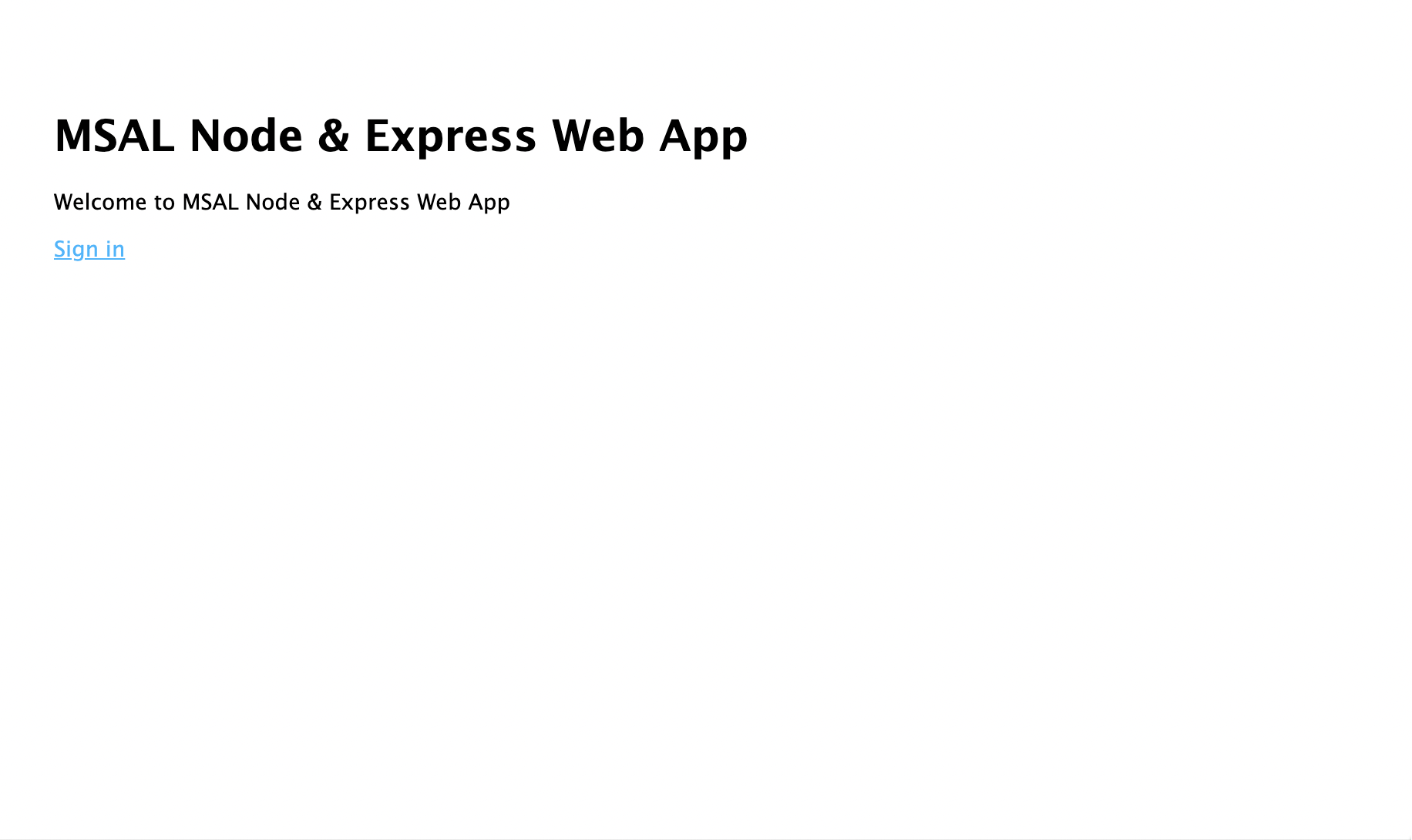
- 選取 [登入] 連結。 您應該會看到 Microsoft Entra 登入畫面:

- 輸入認證之後,您應該會看到同意畫面,要求您核准應用程式的權限。
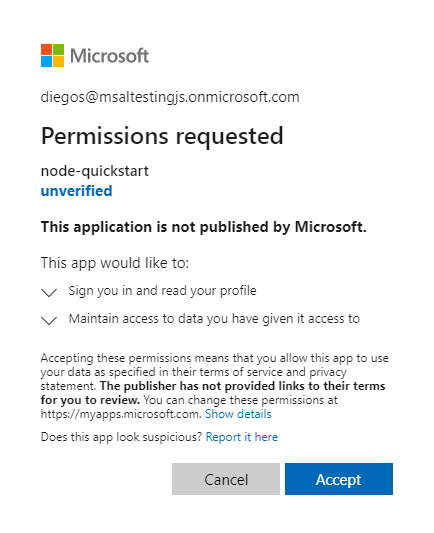
- 在您同意之後,您應該重新導向回應用程式首頁。
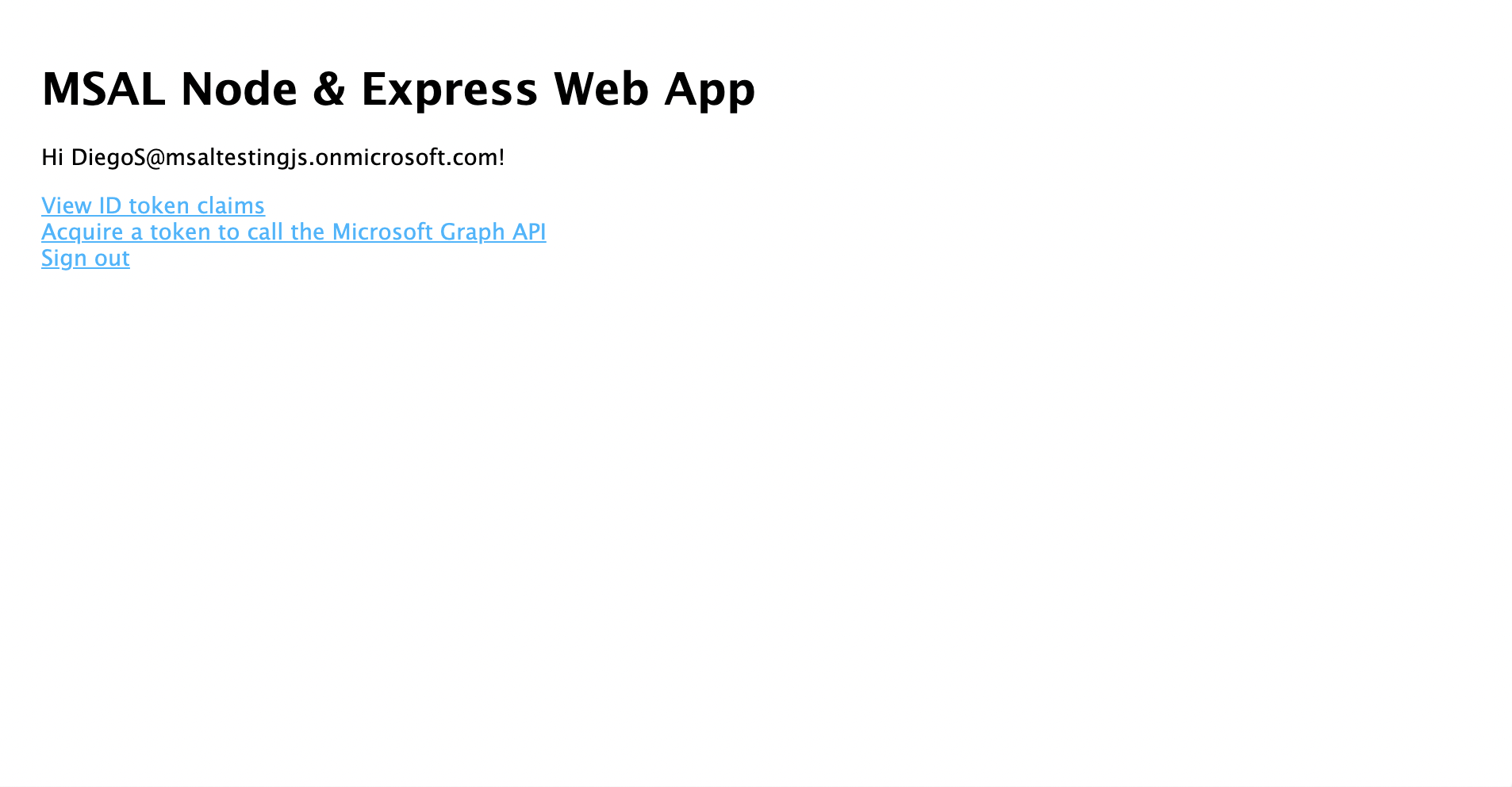
- 選取 [檢視識別碼權杖] 連結,以顯示已登入使用者識別碼權杖的內容。
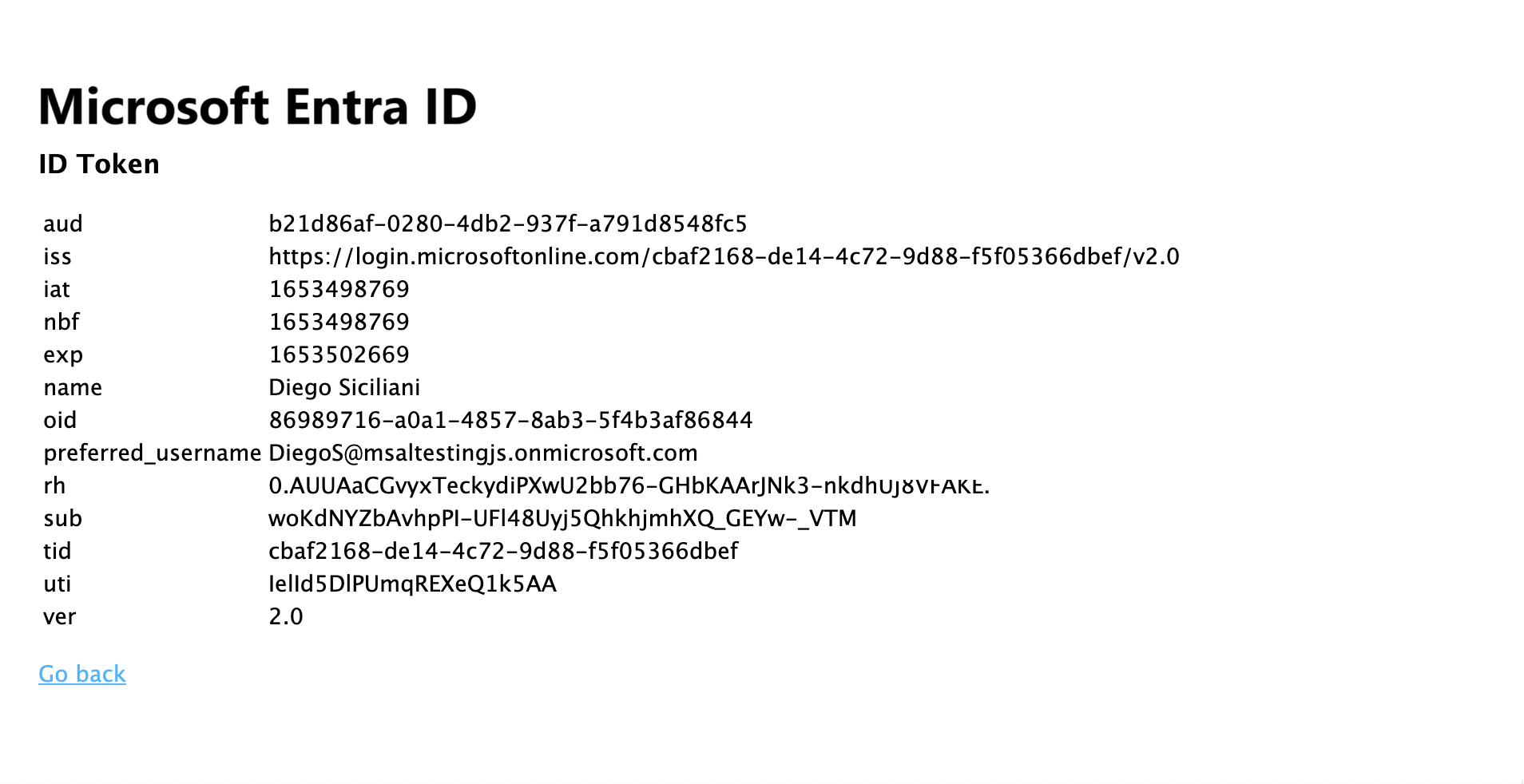
- 返回至首頁,然後選取 [取得存取權杖並呼叫 Microsoft 圖形 API] 連結。 完成之後,您應該會看到來自 Microsoft Graph/me 端點的回應,以供已登入的使用者使用。
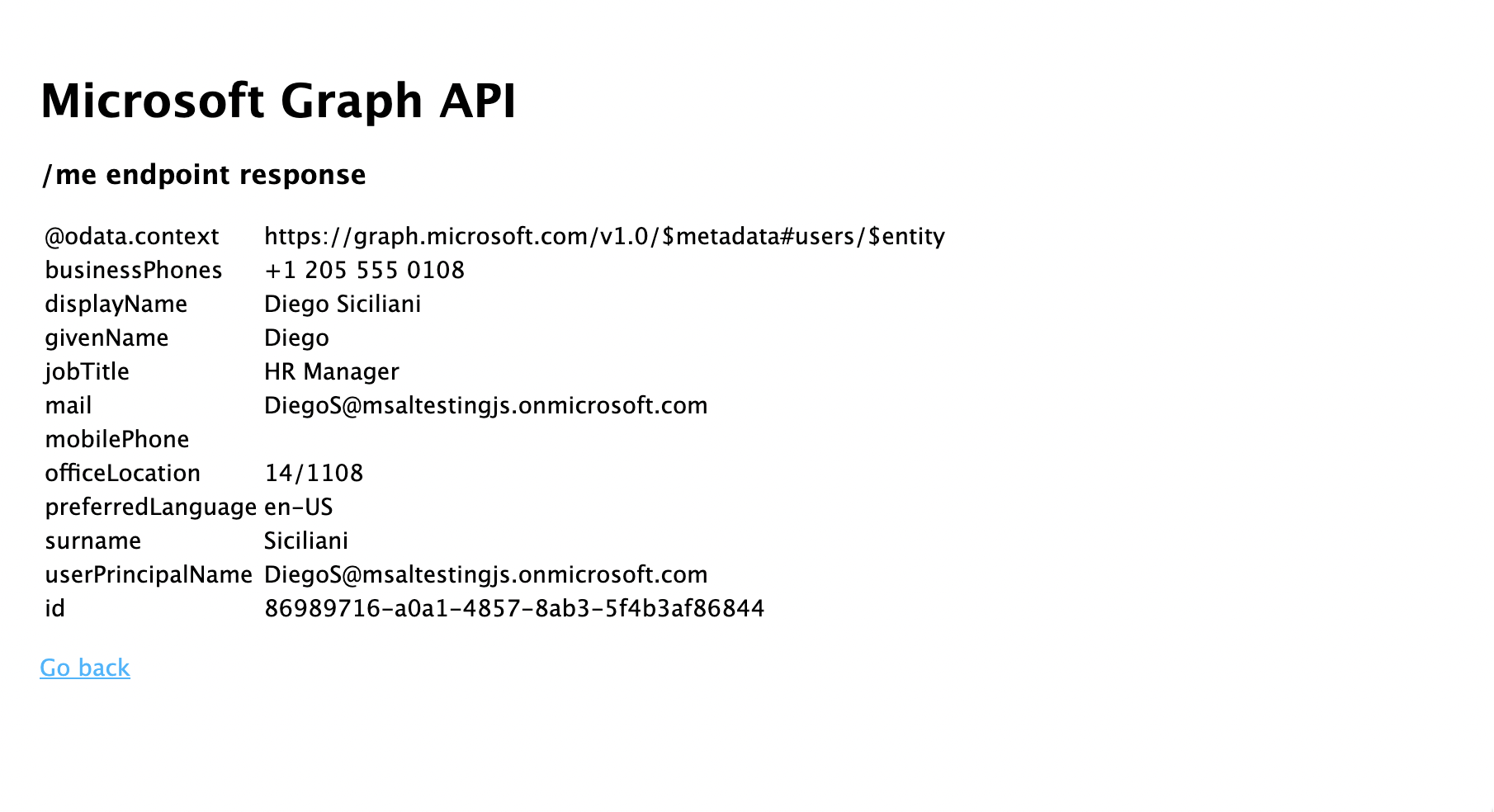
- 返回至首頁,然後選取 [登出] 連結。 您應該會看到 Microsoft Entra 登出畫面。
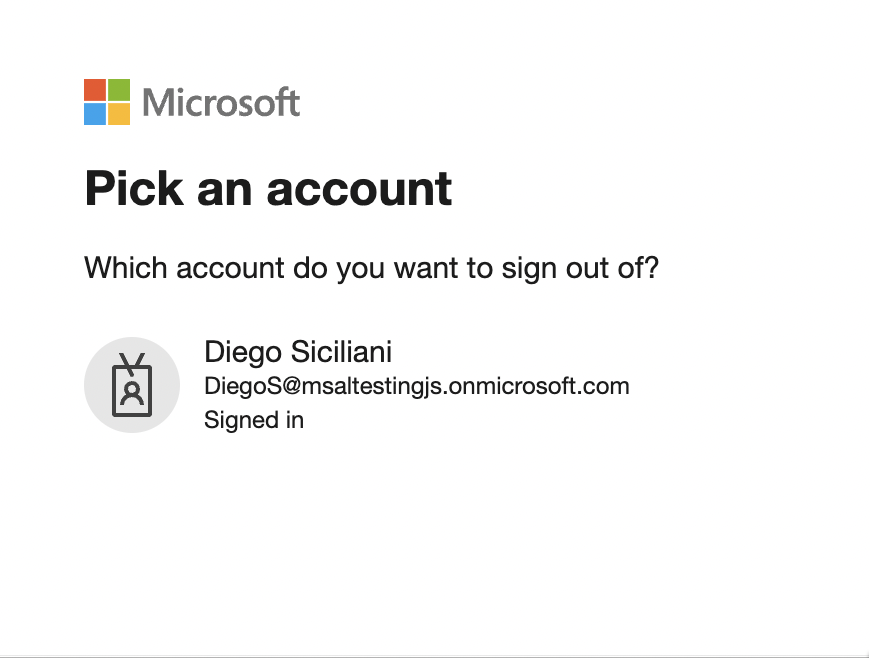
應用程式的運作方式
在本教學課程中,您已具現化 MSAL Node ConfidentialClientApplication 物件,方式是對其傳遞設定物件 (msalConfig),其中包含在 Azure 入口網站上從您的 Microsoft Entra 應用程式註冊中取得的參數。 您所建立的 Web 應用程式會使用 OpenID Connect 通訊協定來登入使用者,並使用 OAuth 2.0 授權碼流程取得存取權杖。
下一步
若要深入了解如何在 Microsoft 身分識別平台上開發 Node.js 和 Express Web 應用程式,請參閱我們的多部分案例系列: